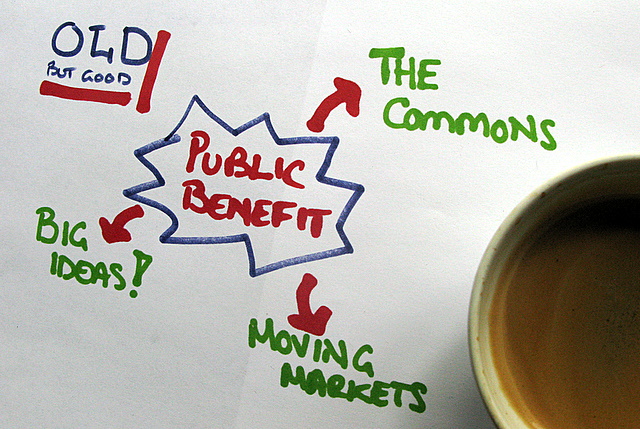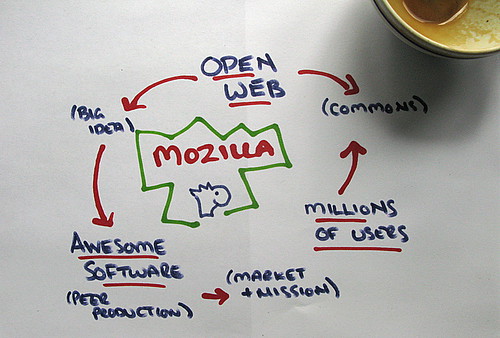It’s been fun reading reactions to my first post on hybrid organizations. The conversation so far has underlined one very critical point: we are talking about something that is at once very old and very new. While I hinted at this last time, it feels like its worth digging deeper on which bits are old and which bits are new.

The idea of people organizing for the public benefit is almost as old as the hills. England started calling these organizations charities and created a law to support them around 1600. Before that, maybe people just called it ‘community’, or took for granted that we should get together to help each other out? Whatever we call it, this impulse to make things better — and to organize around it — runs deep. It is not new.
What is new is the toolbox that hybrid organizations draw from. Cheap global networks. A willingness to use markets as a channel to drive change. Collaborative peer production. Combined with the 500 year tradition of public benefit organizations, these new tools make it possible to organize huge numbers of people to create massively scaled, tangible public goods that out-compete what’s broken and make things better on a global scale. For me, it’s this mix that makes hybrids interesting.

If we push on ‘what’s old?’ for a moment, it’s clear that the hybrid orgs I am talking about build upon well established public benefit roles and traditions:
1. Championing important ideas. One of the first things we think of when we hear ‘public benefit organization’ is championing a big, important idea. History is filled with examples of organizations gathering millions to do everything from claiming their civil rights to protecting our planet to toppling colonial governments. The public benefit organizations behind such movements have not just been important, they have in many cases been transformative. When successful, they have changed the thinking of not only governments and businesses but whole societies for the better.
2. Protecting the commons. The idea of building and protecting things we hold in common like ‘bridges, seabanks and highways‘ has been recognized as a public benefit right from the outset of charity law. And of course, organizing people — and money — to protect the commons remains a major role for public benefit organizations today. Just think of libraries. Or the neighbourhood watch. Or organizations that protect forests and wildlands. These common assets are not just ‘nice to haves’. They are essential ingredients in a rich, healthy society. They make it easier to learn, keep us safe and clean the air. And, in the end, they even make it easier to do business. Organizations that protect common public goods play an essential role in our world.
3. Making markets wiser and more humane. Companies and markets don’t always do the right thing. In the last 50+ years, we’ve seen an increasing number of organizations that have tried to ‘move the market’ in ways that make it wiser and more humane. Organizations like the Forestry Stewardship Council, which has become the gold seal for planet friendly wood products, have shown that creating incentive for market players to improve their behaviour can make the world better for everyone. Many other organizations try to move markets in similar ways, using everything from humour to boycotts. The goal is not to be the market, but to make it easier for markets to feed, strengthen and respect the rest of what makes the world tick.
All three of these public benefit roles and traditions are important. But pursing these roles using the traditional organizing models of the not-for-profit sector has significant limitations and challenges. Turning big ideas and mass movements into concrete change is hard, and a bit of a crap shoot. Scaling the commons and out-competing enclosure requires — or at least has required — huge resources. Finding enough strength and influence to truly move markets has proven tough for players who are not in the market themselves. For these reasons, public benefit organizations often struggle to have the impact they want to have, or accept that their impact will be small and local.

What’s happening with hybrid orgs is a mashup of old traditions with new tools and ideas in ways that make it more likely that public benefit organizations will have the massive impact they want and need to have. Some of the new tools include:
a. Cheap networks, global scale. Clay Shirky has made it trite to say that the cost of organizing has gone through the floor. The thing is: he’s right, and it’s important. Cheap networks have made it possible for a very small group of people to organize effectively on a global scale. This is especially important for public benefit organizations which have typically had limited impact just because they couldn’t afford to reach out far and wide. The networked world makes it possible — in some cases even easy — to champion big ideas, build the commons and move markets on a global scale. This is genuinely new.
b. Mixing mission and market tactics. The idea of mixing tactics from the mission (volunteerism, calls to action, donations) and market (products, competition, earned revenue) worlds is also fairly new. Social enterprises that develop products and services as a way to pursue their mission have really only been around since the 1980s. Organizations like Mozilla and Kiva that try to keep markets doing the right things for the commons on a massive scale are even newer. Despite this newness, the idea that mixing mission and market is a legit public benefit strategy is seeping into the public (and more slowly government) consciousness.
c. Collaborative peer production. In the past, it the public goods created by non-profits and charities were by there very nature small and local. Collaborative peer production — the idea that many people on the internet can pitch in a small amount of effort to make something big — has changed that dramatically. A top quality, standards-based web browser. A massive, high quality encyclopedia. A huge alternative financing pool for poor entrepreneurs. No — or certainly few — public benefit orgs could have created such things 25 years ago. Peer production and open source changed this. The result: there are now organizations that can create public goods of a quality and scale that can directly move markets in ways that benefit the commons. These organizations don’t just describe big new ideas. Using the power of mass contribution, they make them real.

It’s the mashup of all these old and new elements that is the hallmark of the hybrid organizations I am talking about. Mozilla protecting the Internet commons by engaging millions of people to move the market. Wikipedia organizing people to create tremendous public asset that gathers the sum of all human knowledge. Kiva building a collaborative bank to move the finance market for the poor. These organizations are mixing the old and the new. They are in the public benefit remix business, figuring out how to get beyond the limitations of the past. From where I sit, that’s exciting, and important.
In my next post, I want to dig deeper into the question of ‘why do hybrid orgs matter’? The fact that we are seeing innovative public benefit organizations mash up the old and the new is cool. But what specifically does it get us? After that, I want to loop back to the challenges faced by public benefit orgs and look at the Mozilla case in a bit more detail. In the meantime, please comment, post and trackback to keep this hybrid org conversation rolling.
You’re certainly drilling down to the gist of the matter now – that’s great. I think you might want to take a look at the concept of a ‘value network’ as it looks to me this might be what you’re alluding to in the manner hybrids function in many ways. You use ‘public good’, ‘public benefit’ and similar terms; I think you’re conflating the terms. A true ‘public good’ is a distinct thing with a distinct definition, as is a public benefit and a valued outcome/impact. Your fourth graphic looks a bit like a proto-value-network model in fact, so I’m thinking these ‘public good’ and ‘value network’ notions might be good lines of inquiry and thinking for you. Another idea: go back to the historical writings on social theory dealing with the foundations of charities, public health, social infrastructure, etc. It’s been a while for me but I recall it was all based on the ‘transformative change’, ‘public benefit’, ‘collective improvement’ and hybrid organizations. Paris sewer system comes to mind: a ‘network’ of networks inspired by public good motivations with built infrastructure created in tandem with private industry. Make sense? Please continue the discussion as it’s a fascinating topic.
This has probably been commented on before, but it seems that the term ‘hybrid organization’ isn’t the right one to use for this concept.
From this more detailed description, it seems that the important thing is not the organization itself, but the new tools and ideas available to organizations. (Plus ‘hybrid organizations’ is very uncompelling in a management theory text book sort of way).
Have other names been suggested that do a better job of capturing all of these details? Networked movement maybe? Open social enterprise? Something else?
David, it sounds to me like you’re talking about some combination of “social entrepreneurship”, a term which has seen a fair bit of use, as practiced via the Internet. I suspect that exactly what phrase captures the nuance you want best is likely to depend on whom on you’re interested in talking to with what specific goal in mind…